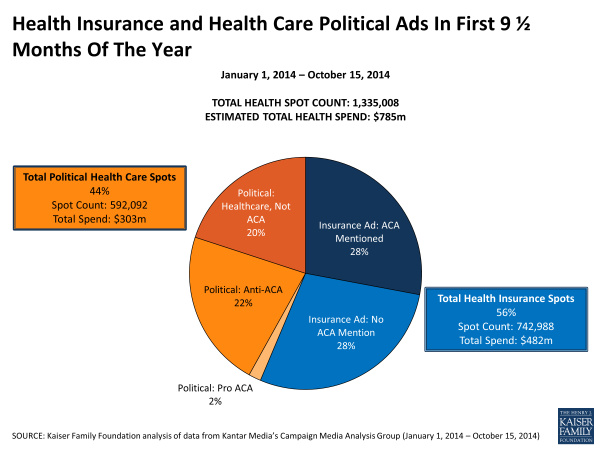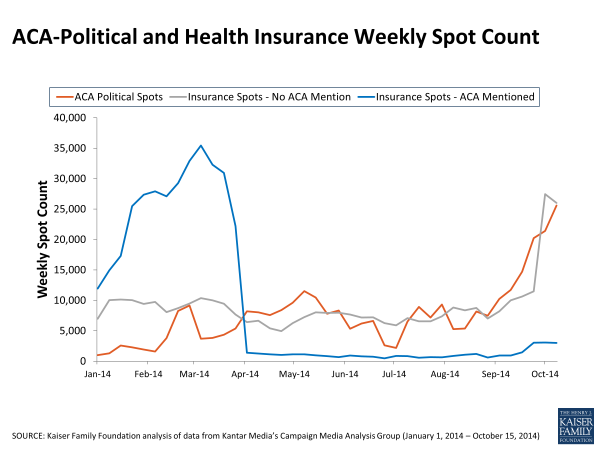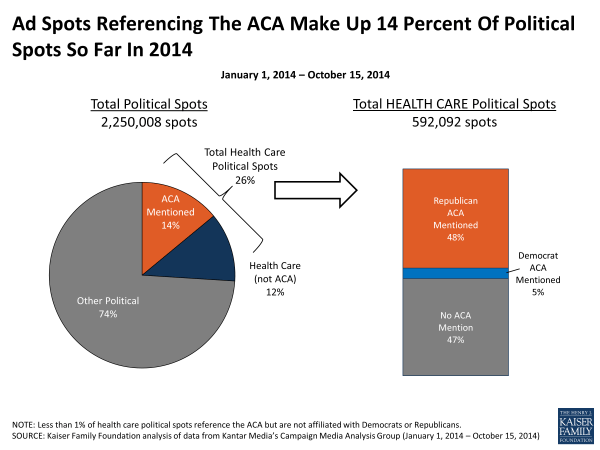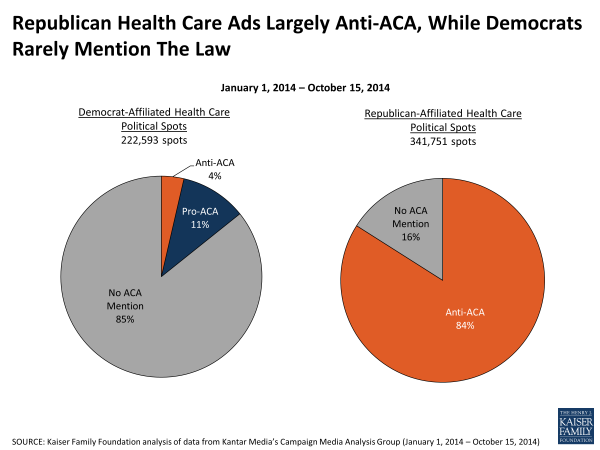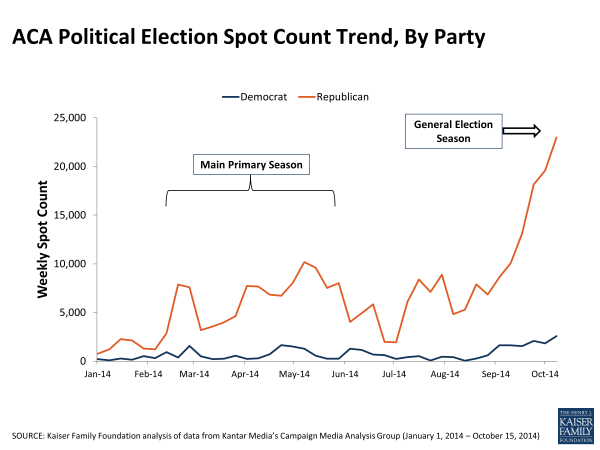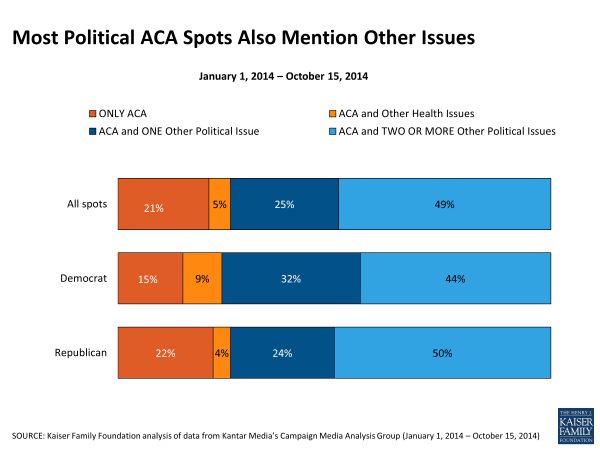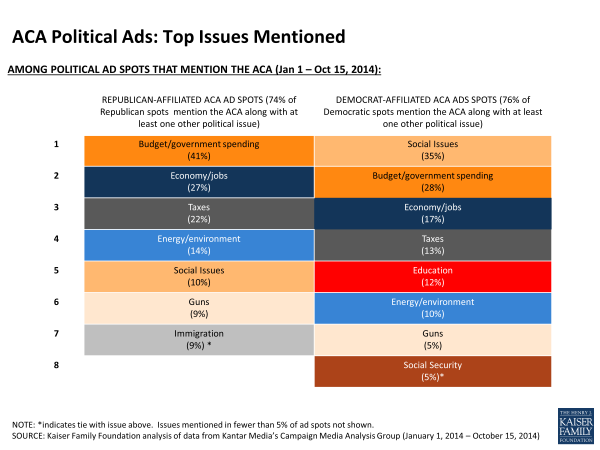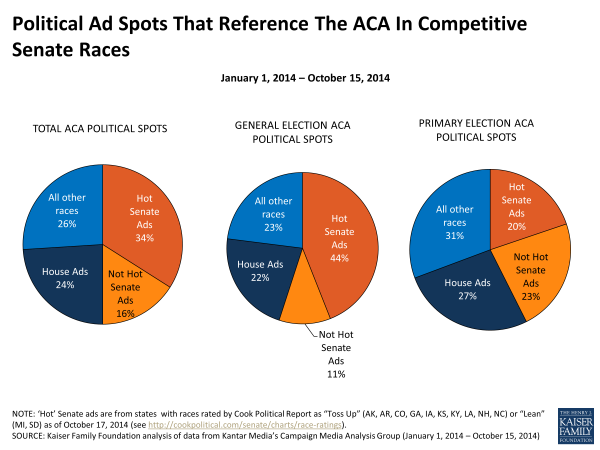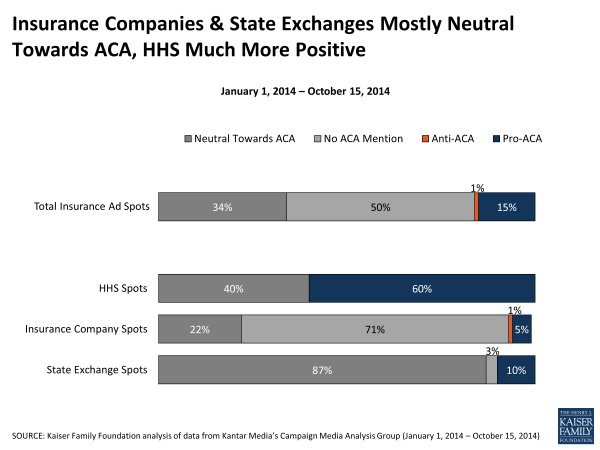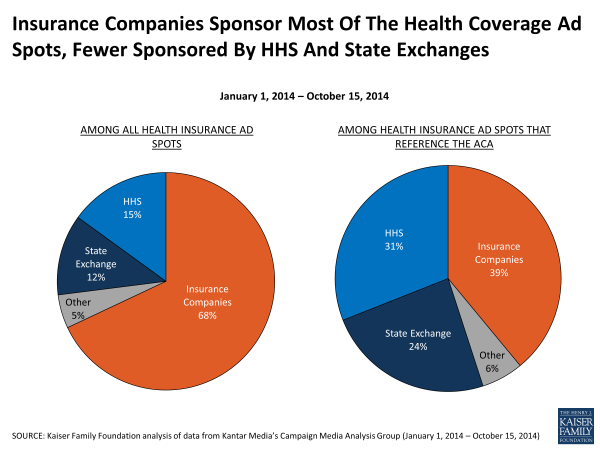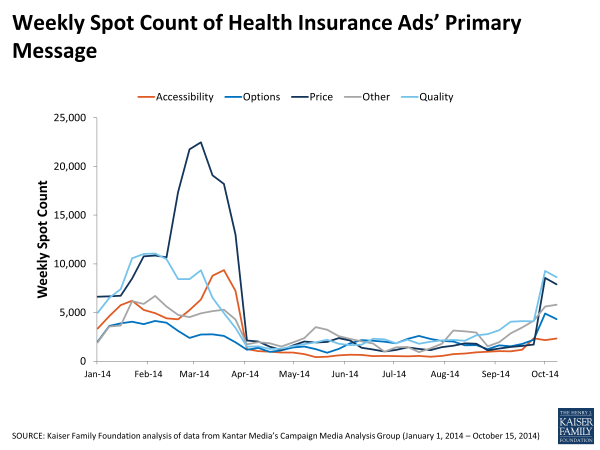ACA Advertising in 2014 – Insurance and Political Ads
Big Picture: Health Insurance Spots Slightly Outweigh Political Spots Referencing Health Issues
To date in 2014, over 1.3 million health insurance and political ads that reference health care issues have aired, including those aimed at getting people to sign up for health insurance and those using the ACA as a political tool to engage and influence voters. A majority of these ad spots have been advertising insurance products or encouraging people to enroll in coverage (56 percent), including 28 percent that specifically mention the ACA. The other 44 percent have been political ads that mention health care issues, including 24 percent that specifically mention the ACA (Figure 1). As insurers embraced this unique opportunity to access a new customer base and governments and non-profits engaged in outreach, spending on health insurance advertising is approaching half a billion dollars (about $482 million) and spending on political ads mentioning health care is at about $303 million as of mid-October.
Were TV Viewers Getting Mixed Messages During Open Enrollment?
With the combination of the two open enrollment periods and the mid-term elections in 2014, are Americans getting mixed messages when it comes to TV advertising about the ACA? On one hand, insurers and advocates of the law are appealing to Americans to enroll in coverage, while on the other, politicians are largely using the ACA in a negative light to relate to voters with a mutual dislike of the law or to persuade them to oust incumbents who supported it.
During the second part of the first open enrollment period (January 1 – March 31, 2014), there was a mountain of health insurance advertising spots that specifically mentioned the ACA as well as numerous other insurance ads (Figure 2). Because the open enrollment period came before most primary races began to heat up, there were fewer ACA-political ads during this time, although it is notable there were any this early in the election cycle. About this same time, according to the Kaiser Health Tracking Poll, about 6 in 10 Americans reported seeing an ad that provided information about how to get insurance under the law and about half said they saw an ad for an insurance company promoting health insurance products (see Appendix). Although political ads referencing the ACA were airing much less frequently during this time, about 6 in 10 Americans said they had recently seen ads that were opposed to the law, in support of the law, or were trying to influence their vote for a political candidate based on their stance on the law.1 After April 1st, insurance advertising mostly returned to normal; insurance ads that referred to the ACA dropped off to nearly nothing, while television viewers continued to see more general health insurance advertisements along with an increasing number of campaign ads. Now, as the general election and the next open enrollment period are approaching, there has been an uptick in the amount of spots airing. Insurance ads that do not reference the ACA have recently begun to keep pace with ACA-political ads at least in part due to Medicare’s open enrollment period.
The ACA Advertising and Latinos
As both the mid-term elections and the launch of the second open enrollment approach, Latinos around the country are likely seeing ads from insurers and political campaigns. Targeting potential health insurance enrollees, about one in ten (10 percent) of all health insurance ad spots so far this year were in Spanish. Most of these Spanish language ads were sponsored by insurance companies (58 percent), with fewer sponsored by state exchanges (25 percent) and HHS (6 percent). These ad spots were geographically concentrated in states with large Spanish-speaking Latino populations, with most airing in California (30 percent), Texas (24 percent), Florida (11 percent), New Mexico (8 percent). Although political candidates may be reaching this politically important group in a variety of other ways, so far this year, no Spanish language political television ads mentioning the ACA have been identified.
Political Ads & Health Care
Political advertisements in 2014 include both primary and general mid-term election campaign ads, of which 26 percent specifically mentioned health care issues, including 14 percent that specifically mention the Affordable Care Act (Figure 3).
About Half Of Health Care Political Ad Spots Mention The ACA
As a share of all health care political advertising spots, about half (53 percent) reference the ACA, “Obamacare,” or a specific provision available under the law. Most of these ads are sponsored by Republicans and are negative towards the law (48 percent) while just a few (5 percent) are sponsored by Democrats (Figure 3), including 4 percent that include pro-ACA content and 1 percent with anti-ACA content.
In a recent Kaiser Health Tracking Poll2 voters are more likely to report seeing more ads in opposition to the ACA than in support (23 percent vs. 6 percent), while the majority say they’ve seen an equal share or that they haven’t seen any ads (see Appendix). Kaiser Tracking also finds that similar shares of people identifying as Democrats and Republicans say the health care law is the most important to their vote even though political advertising about the ACA in particular has been dominated by Republicans.
Democrats and Republicans highlight different issues in their healthcare-related advertising. Republicans included ACA messaging in 84 percent of their ad spots that cover health issues, compared to 15 percent for Democrats (Figure 4). Democrats have been steering away from the ACA this election cycle, preferring to talk about other health care issues, including Medicare, health benefits for veterans, women, and undocumented immigrants. Nearly half (46 percent) of Democrat-affiliated health ad spots mention Medicare (Figure 5) with messaging, for example, that includes concern about Republicans restructuring Medicare or requiring seniors to pay more for prescription drugs.
|
Figure 5: Percent Of Total Political Health Care Spots Mentioning The Following Issue… |
|||
| Total | Democrats | Republicans | |
|
…Anti-insurance
|
5%
|
10% | 2% |
| …Medicare | 26% | 46% | 16% |
| …Anti-ACA | 50% | 4% | 84% |
| …Pro-ACA | 4% | 11% | 0% |
| Note: Each advertising spot may be categorized with more than one of these issues. | |||
Unique Anti-ACA Ads
Since the beginning of the year, there have been 849 unique political ads that reference the ACA. Of these ads, the vast majority of them (746 unique ads) were affiliated with Republican candidates, and all were anti-ACA. Democrats, on the other hand, were not entirely united in their position on the ACA; 22 percent of their 83 unique ads contained anti-ACA messaging while the majority (78 percent) were pro-ACA.
During primary election season, most anti-ACA ads had a positive tone, highlighting a candidate’s consistent record in opposition to the law, or like Arizona Gubernatorial candidate Doug Ducey, promising to “stand up to the Obama Administration”. However, general election campaign ads that mention the ACA had turned mostly negative, like an attack ad in Arkansas’s Senatorial race, which criticizes incumbent Mark Pryor for being “the deciding vote for Obamacare, which will cut Medicare Advantage benefits for our seniors”.
Anti-ACA political ads were sponsored by over 300 different candidates or issue groups with most accounting for less than 1 percent of unique anti-ACA political spots. Notably, however, Americans For Prosperity sponsored 7 percent of unique anti-ACA spots, far higher than any other individual group. Two individual ads stand out for having a total cost of more than $2 million each. Both were attack ads sponsored by the Florida Republican Party against Charlie Crist in the hotly contested race for Florida Governor. The overall cost for each ad is estimated to be over $2.3 million and $2.7 million and together the ads were aired about 9,000 times.
ACA Political Messages Vary
As noted by media outlets and others, the messaging about the ACA within these ads also varies by party. Republican ads are straightforward about their negative view of the law while Democratic ads in support of the law often avoid mentioning it by name and instead often focus on specific provisions put in place under the law. For example, an anti-ACA ad from Florida Republican Party mentions “Obamacare” five times and attests that the law has harmed doctors, patients, and job creation. On the other hand, Democratic ads tend to be much more tempered in their use of the ACA. For example, an ad from House Majority PAC in West Virginia’s race for the third congressional district seat doesn’t mention the law by name, but instead references the provision of the law that prohibits insurance companies from charging women more than men for their health coverage.
Unique Pro-ACA Ads
The vast majority of political advertising about the Affordable Care Act was negative. Of the 849 unique political ads aired to date that reference the ACA, only 65 were messages in support of the law, including 24 primary election ads, 40 general election ads, and one special election ad. Most of these ads were for US House seats (32 unique ads), US Senate seats (21 unique ads) or gubernatorial races (9 unique ads), plus three state congressional races; unsurprisingly, all were sponsored by Democrats.
So far this year, the most-aired and most expensive pro-ACA ad campaigns were for primary election battles. The most-aired pro-ACA ad was an attack ad that aired over 1,200 times in North Carolina by sponsor Patriot Majority USA against Republican senatorial candidate Thom Tillis. Like other “ pro-ACA” ads, the ad did not refer to the ACA directly, but rather talked around it by mentioning certain provisions, including those that protect individuals with pre-existing conditions and lower cost sharing for preventive care services.
Of the 40 pro-ACA ads of the general election, the most expensive pro-ACA ad so far is an ad from Joe Garcia, Democratic incumbent in the hotly contested FL-26 House seat, criticizing his Republican challenger Carlos Curbelo for his opinion on a number of health-related issues, including his position against key ACA provisions. The estimated total cost of the ad is $753,090 and was aired 1,087 times in Florida. An ad from Mark Udall, Colorado’s incumbent Senator, also ranked among the most expensive, costing an estimated $621,780 total and airing 1,043 times.
These two ads cost a substantial amount more than any other pro-ACA general election ad, with the runner-up Planned Parenthood Votes spending an estimated $371,800 on an ad against the North Carolina Senate candidate Thom Tillis that aired 434 times.
ACA Political Ads Over Time
At each point during this election year, Republican political ad spots mentioning the ACA far outnumbered Democratic spots. There were several bumps in the amount of Republican spots using the ACA during primary season and the number of ad spots is now peaking as the general election approaches (Figure 6). Democratic political spots with ACA messaging have also ebbed and flowed over the course of the year, but remain far below the level of ACA advertising sponsored by Republicans.
For ACA Political Ad Spots, The Law Is One Of Many Issues Mentioned
About three-quarters of ACA political ad spots mention the ACA along with at least one other political issue, such as the economy or government spending (Figure 7). A fifth (21 percent) of ACA political ads focus exclusively on the ACA and don’t mention any other issue while another 5 percent mention the ACA along with other health issues, such as prescription drugs, Medicare, or objections to insurance company practices. Both Democrats and Republicans are mostly talking about the ACA along with other issues, rather than airing ads focused on the ACA exclusively.
The other issues mentioned in these ACA ads largely follow somewhat typical partisan rhetoric with Democrats being more likely to pair the ACA with social issues and government assistance while Republicans are more likely to raise the issue along with messages of government intrusion and fiscal irresponsibility. Along with the ACA (or Obamacare, as it is often referred to in these ads) about four in ten (41 percent) Republican ad spots also mentioned the federal budget or government spending, followed by the economy and jobs (27 percent) and taxes (22 percent) (Figure 8). About a third of Democratic ACA spots (35 percent) include messaging about social issues, such as abortion, gay rights, and women’s rights. The next most commonly referenced issues in Democratic ACA ads are the budget (28 percent) and the economy and jobs (17 percent).
Competitive Senate Races
So far this year, a third of ACA political ad spots have been for competitive Senate races, defined as those races designated by the Cook Political Report as “Toss Up” or “Lean” races (Figure 9).3 In the general election ad campaign, over 4 in 10 ACA political ad spots (44 percent) have been for competitive Senate races, whereas primary election spots were more scattered across a variety of races. The people living in these competitive states are more likely to say they’ve seen campaign ads related to the ACA than others, including more ads with anti-ACA messaging (see Appendix).
Overall Health Insurance Advertising Landscape
In addition to the political ads mentioning the ACA, health insurers, state and federal governments, and non-profit organizations are advertising about health insurance in order to encourage people to enroll and buy health insurance coverage. Half of all health insurance ad spots did not mention the ACA at all (50 percent) (Figure 10). Another 34 percent of health insurance ad spots mention the ACA in a neutral way, while 15 percent are positive toward the law and just 1 percent are negative towards it. Ads that are positive about the law point out specific ways people may benefit, for example, access to quality coverage, getting financial assistance and ease in shopping and comparing plans. Health insurance ads that are negative toward the law refer to people having trouble using the government website, or refer to the rising cost of medical care. Neutral ACA health insurance ads often allude to the ACA’s effect on the changing health insurance landscape and offer to be a source of information on healthcare reform, or refer to an element of the law, such as a state exchange, open enrollment, or financial assistance.
Most (71 percent) insurance company ads did not mention the ACA, while almost all ads from the US Department of Health and Human Services (HHS) and state exchanges did refer to the law. HHS ads tended to be more positive toward the law, with six in ten ad spots containing pro-ACA messages (Figure 10). State exchanges, on the other hand, were almost entirely neutral on the topic; just 10 percent of state exchange ad spots had a pro-ACA message.
Unique Health Insurance Ads
Out of the total 1,900 unique insurance ads, about six in 10 did not mention the ACA at all. Those that did mention the ACA specifically were mostly neutral (621 unique ads), with a few that were pro-ACA (123 unique ads), and only a handful that were anti-ACA (11 unique ads). Insurance ads that mentioned the ACA aired an average of 487 times and had an average total cost of about $195,000. Many ads, including those aired across several states, had significant overall costs. Five unique ads that mentioned the ACA had an estimated overall cost of more than $3 million each for total airtime between January 1st and October 15th. Three of these ads were sponsored by insurance companies – two from Humana and one from Anthem Blue Cross/Blue Shield – and two were sponsored by HHS. Humana spent far more on a single unique ad than any other health insurance advertiser, with an estimated total cost of over $45 million. The ad was aired 4,475 times across 146 local media markets as well as a national television and cable networks. One of the HHS ads promoting healthcare.gov featured Magic Johnson and is estimated to have cost nearly $4 million for 3,094 airings.
Among health insurance ads, most (68 percent) ad spots were sponsored by insurance companies themselves, 15 percent were sponsored by HHS, and state exchanges made up 12 percent of total ad spot sponsorship (Figure 11). Looking only at health insurance advertising that refers to the ACA, sponsorship spans across health insurance companies (39 percent), HHS (31 percent) and state exchanges (24 percent). Advertising from state exchanges was concentrated in three states – California, Illinois and New Mexico – accounting for three-quarters of what exchanges aired.
The primary message included in health insurance advertising changed over the first three months of the year. As the end of open enrollment neared, the number of health insurance ads focusing on price and accessibility increased (Figure 12). Health insurance ads focusing on the cost of coverage tracked with ads focusing on quality during the first month and a half of the year, but in early March, ads focusing on price spiked. The attention to the cost of coverage in the advertising reflects the barrier affordability can play in expanding coverage. For example, in Kaiser’s January Health Tracking Poll nearly half (45 percent) of the uninsured said that the main reason they didn’t have insurance was because they felt it was too expensive. 4
Conclusion
This analysis of political advertising referencing the ACA and health insurance ads promoting enrollment in new coverage options or advertising specific insurance products shows that, over the course of the year, American TV viewers have been exposed to a variety of messages related to the ACA. These messages may often be conflicting with most of the political ads portraying the ACA in a negative way while insurance ads, even if they are not referencing the ACA directly, are promoting health insurance more generally, something that the law made available to more people. This balance of advertising may be playing out differently across the country due to the presence of competitive elections and the variations in how the ACA is being implemented in various states.
This analysis also shows that the ACA has become a standard reference in partisan discourse – routinely being weaved into the fabric of any partisan’s list of issues used to distinguish one party from another. Relatively few spots aired that exclusively talk about the ACA as a standalone issue, rather the vast majority of the political advertising referencing the ACA includes mentions of other issues, including the federal budget, the economy and jobs, and social issues.
With the midterm election next week and the next open enrollment period beginning just 11 days after that, Americans are surely seeing more health insurance and political advertising that references the ACA. As of October 15, there has been a recent uptick in both political ad spots referring to the ACA as campaigns make their final pitch to voters, and an increasing number of health insurance ad spots that are most often tied to the Medicare open enrollment period. Health insurance spots using the ACA in their content have yet to increase substantially, but will likely do so as the November 15 start date for open enrollment approaches.

